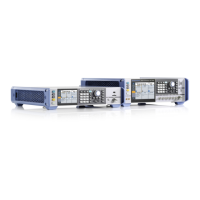Improving Level Performance
R&S
®
SMA100B
229User Manual 1178.3834.02 ─ 05
Determine T<ch>
Operand1
in the entry field next to "Tx", and then select T<ch>
Operand2
in
the second entry field right to it.
The result ("T<ch>
result
") is assigned to the above selected "Trace". If switched on, the
graph shows the resulting curve.
Note:
Depending on the type of trace, the instrument automatically sets the appropriate unit
on the y-axis:
●
"dBm" if it shows only measurement traces.
●
"dB" for purely mathematical curves.
●
"dB/dBm" ratio scale for mixed display, that means measurements and mathemati-
cal curves.
Example:
Example of a nested calculation.
●
T1 shows the result of the subtraction of the trace ("Trace 1"), and the reference
curve.
●
Trace2 subtracts Ref from T1.
That illustrates the nested calculation, since T1 covers already a math operation.
Note: "(Ind.)" denotes the currently selected trace.
Remote command:
:CALCulate[:POWer]:SWEep:FREQuency:MATH<ch>:STATe on page 449
:CALCulate[:POWer]:SWEep:FREQuency:MATH<ch>:SUBTract on page 450
:CALCulate[:POWer]:SWEep:POWer:MATH<ch>:STATe on page 450
:CALCulate[:POWer]:SWEep:POWer:MATH<ch>:SUBTract on page 450
:CALCulate[:POWer]:SWEep:TIME:MATH<ch>:STATe on page 453
:CALCulate[:POWer]:SWEep:TIME:MATH<ch>:SUBTract on page 453
Markers Settings
Access:
1. Select "Clk Syn/Power Sens" > "NRP Power Analysis".
2. Select power sensor indication located at the bottom of the dialog.
Using Power Sensors

